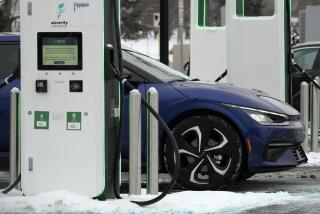Alcohol Fuel, Natural Gas Urged in Cars
- Share via
WASHINGTON — use of alcohol fuels and natural gas in motor vehicles could significantly improve urban air quality while reducing fuel costs, a federal task force headed by Vice President George Bush said Tuesday.
The Presidential Task Force on Regulatory Relief said the wider use of methanol and ethanol fuels--two forms of alcohol--could help about 80 metropolitan areas, many of them in California, to meet stringent federal air quality standards that would otherwise require further emission controls or restrictions on city driving.
The Environmental Protection Agency says that 76 metropolitan areas do not comply with federal limits on ozone pollution and that 80 areas fail to meet carbon monoxide standards. The EPA estimates that most of them will miss a Dec. 31 deadline for complying, after which the federal government is empowered to withhold funds for highway construction and take other economic sanctions.
Credit for Effort
EPA officials have said it is unlikely that sanctions will actually be imposed on states that have made major strides toward improving air quality. The threat of sanctions, however, led the Administration last April to look for ways of helping cities to meet the standards without adding to the burden of federal regulations.
The report released Tuesday was based on studies by the EPA and 11 other agencies and outlined the benefits of a technology that attracted wide interest in the 1970s as world oil prices soared, then faded as the cost of gasoline stabilized and eventually fell.
The report contends that vehicles burning compressed natural gas or a mixture of methanol and gasoline could yield a 15% to 20% reduction in emissions of the hydrocarbons that lead to ozone, a major component of smog.
Advanced engines designed to run on pure methanol could reduce the precursors of ozone by up to 95% and sharply reduce carbon monoxide emissions, the report said. Methanol is usually made from natural gas but can also be made from coal, whereas ethanol is fermented from grain. Coal and grain are abundant in the United States.
Projecting the costs of alternative fuels, the EPA estimated that a mixture of 85% methanol and 15% gasoline would add $270 a year to a vehicle’s operating costs in 1990, assuming that gasoline cost $1.04 a gallon. By 1995, if gasoline rises to $1.33 a gallon, the EPA said, the methanol mixture would save drivers $60 a year and a pure methanol fuel would save $245 a year.
The presidential task force’s executive director, Wendy Gramm, said the group had endorsed a recommendation that the EPA encourage states to adopt alternative fuel programs and give them “guidance” on their use for meeting air quality standards.
In addition, the government’s General Services Administration has agreed to promote the development of “flexible-fueled vehicles,” which can run on a variety of alternative fuels, by issuing a call for proposals from private industry next year to build 5,000 such vehicles. At the same time, the Urban Mass Transit Administration has agreed to consider expanding its six demonstration programs for methanol-fueled buses to include buses that run on compressed natural gas.
“There are some deadlines coming up with some pretty strong sanctions,” Gramm said in a news conference. “Here, the EPA has come up with something that explains to localities the alternatives they can take.
“Basically, the technology is out there.”
More to Read
Get the L.A. Times Politics newsletter
Deeply reported insights into legislation, politics and policy from Sacramento, Washington and beyond. In your inbox twice per week.
You may occasionally receive promotional content from the Los Angeles Times.










